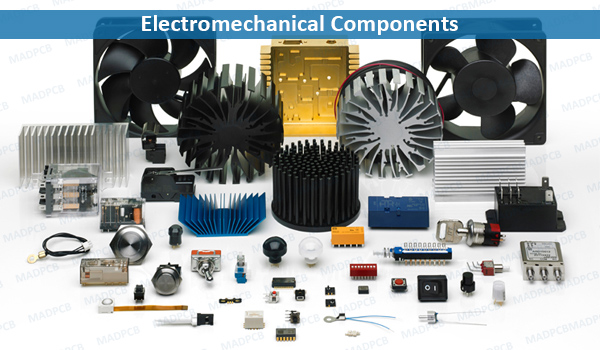Electromechanical Components, or Electromechanical Parts can carry out electrical operations by using moving parts or by using electrical connections. An electromechanical component is one that uses an electrical signal to cause some kind of mechanical change, such as motor turning. These normally use an electrical current to create a magnetic field which causes a physical movement.
- Piezoelectric Devices, Crystals, Resonators (crystal, ceramic resonator, ceramic filter, SAW filters, ultrasonic motor)
- Terminals and Connectors (Terminal, Connector (socket, screw terminal, terminal blocks, pin header)
- Cable Assemblies (Power Cord, Patch Cord, Test Cord)
- Switches (Switch, Keypad, Relay or Contractor, Disconnector…)
- Protection Devices (Fuse, circuit breaker…)
- Mechanical Accessories (Enclosure (electrical), Heat sink, fan)
- Other (PCB, lamp, waveguide, memristor)
Plastic molded or encapsulated components are of increasing importance due to rising requirements for smaller, lighter, and more compact designs with cost efficient pricing. Wherever mechanics and electronic meet, electromechanical components can be used in a multitude of applications, such as in automotive, communications, appliance, and consumer electronics engineering. In automotive applications such components are used in ever increasing volumes. In hybrid housings electronic components are integrated into components for increasingly more complex engine management functions. Strip-molded contact parts are for example used for seat adjustment, and airbag sensors; assembled contact parts are important functional components among others for memory mirror positioning units.
Electromechanical components usually consist of stamped circuit patterns (lead frames) which are coated in the contacting areas with functional surface layers. They serve as the electrical connections of the component to the outside wiring. The lead frames are over-molded with plastics or mounted into plastic molded parts. In addition electronic components can be added to increase the level of product integration. Utilizing the metal–plastic compound the mechanical stability of the plastic is combined with the conduction of electrical energy and electronic signals through the lead frame. In this way protective enclosures for electronic controls of machinery are created which at the same time serve as connecting points to the outside wiring. This can be achieved through hybrid frames and housings. Over-molding of contact components or assembly of different single parts in plastic enclosures can also be used to manufacture electromechanical components.
For achieving the highest possible functionality of the end product a close cooperation between the manufacturer and the end user in the early phases of development and design of new custom tailored electromechanical components is recommended. Innovative and cost-efficient designs can be realized through the combination of the know-how of the manufacturer in for example contact, coating, stamping, plastics processing, and assembly technologies and the mostly rather complex requirement profile given by the end user.
Also see Active Components and Passive Components.

